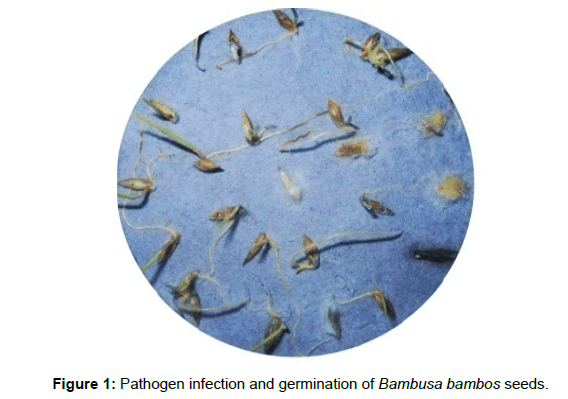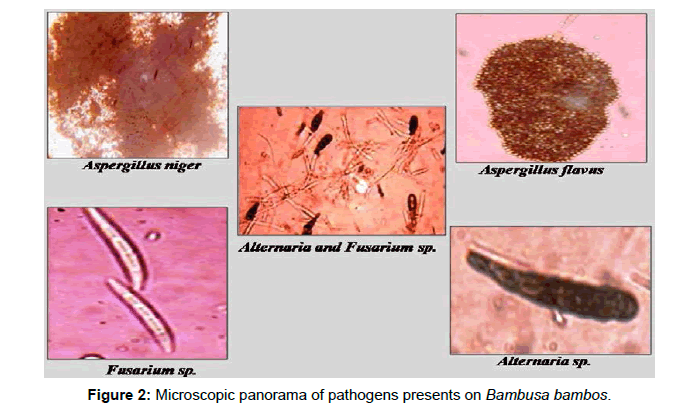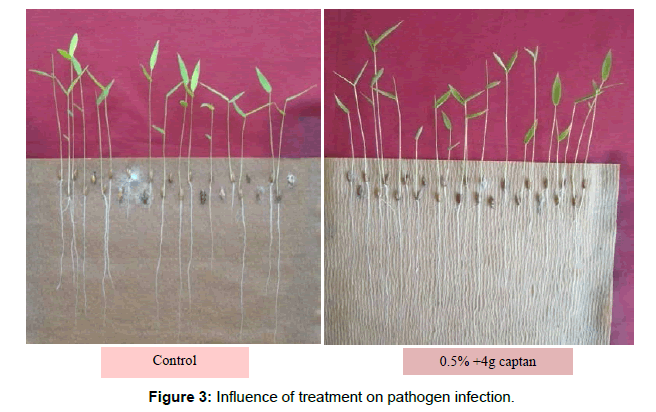Research Article, Vegetos Vol: 31 Issue: 1
Seed Pathology Studies in Bamboo (Bambusa bambos (L.) Voss)
Renganayaki PR1*, Sangareswari M1, Nagajothi2 and Ramamoorthy K3
1Department of Seed Science and Technology, Forest College and Research Institute, Mettupalayam, Tamil Nadu, India
2Department of Silviculture, Forest College and Research Institute, Mettupalayam, Tamil Nadu, India
3Seed Centre, TNAU, Coimbatore, Tamil Nadu, India
*Corresponding Author : Renganayaki PR
Department of Seed Science and Technology, Forest College and Research Institute, Mettupalayam, Tamil Nadu, India
Tel: 9486587062
E-mail: prr1966@gmail.com
Received: June 07, 2017 Accepted: January 08, 2018 Published: January 12, 2018
Citation: Renganayaki PR, Sangareswari M, Nagajothi, Ramamoorthy K (2018) Seed Pathology Studies in Bamboo (Bambusa bambos (L.) Voss). Vegetos 31:1. doi: 10.4172/2229-4473.1000391
Abstract
Bamboos are naturally propagating both sexually and asexually from seeds and rhizomes. Ground collected seeds often infect with soil borne pathogens and it invades during germination and causes secondary infection. During seed storage, pathogens multiply and affect the viability of seeds and reduce the storage life. To
examine the presence of pathogens, species, and its influence on seed germination %, freshly collected seeds of Bambusa bambos (L.) Voss were tested by placing four replicates of 25 seeds in petriplate containing wet blotter paper and incubated at 25°C in alternate dark and light (12h) for seven days and examined under microscope. The seeds were heavily infected (39%) and observed less germination (62%). The spores developed in seeds were examined and predominant species observed were Alterneria spp., Fusarium spp., Aspergilus flavus and Aspergilus niger. The seeds were subjected to dry and wet treatment with Bavistin, Ridomil and Captan. Later surface sterilized with Thiourea and Mercury Chloride. Soaking seeds in 0.5% Bavistin solution for 1h, dried back to original moisture content and dry dressing with 4 g of Captan kg-1 of seeds. This was done effectively to control the surface borne pathogens with low infection (5%) and high germination percentage (78) and showed significant difference between treatments.
Keywords: Bamboo seed; pathogen; Infection treatment; Seed germination
Introduction
India is the second richest country in bamboo genetic resources after China. These two countries together have more than half the total bamboo resources globally. Sharma [1] reported 136 species of bamboos occurring in India. The annual economic value of total bamboo consumption has been estimated as $10 billion [2]. The species propagated both by sexually and asexually. In forestry, availability of good quality seeds is an important factor for raising plant stock on a large scale. Many reasons starting from long interval of flowering, improper seed set, high percentage of immature seeds, poor viability, short living period and seed health are the limitations of seed propagation in Bamboo spp.
The ability of seeds to germinate greatly depends upon seed health and storage conditions. The microorganism either external or internal affects the seed quality and seedling vigor by reducing the germination percentage or seedlings becomes less resistant or susceptible to open environment. Several fungi have been found associated with the seeds but only a few of them are pathogenic causing poor germination. Numerous fungi have been recorded on seeds of Bambusa bambos, B. nutans (Wall ex. Munro), Dendrocalamus strictus (Roxb.), Giganto chlaohasskarliana (Kurz) Backer ex Heyne, Thyrso stachyssiamensis (Gamble.) in Thailand [3-5] and in B. bambos and D. strictus in India [6,7]. A total of 65 fungi belonging to 37 genera and two bacteria have been reported on stored seeds of different species of bamboos from India and Thailand. Proper seed treatment prior to raising nursery will reduce the problem of pathogenicity and its further effect on seedling emergence and growth. Mohanan [7] observed a comparatively low incidence of seed microorganisms on seeds stored under low temperature (l5°C) and higher germination (82%), as compared with the seeds stored at 28.2°C (63%). Hot water and fungicidal seed treatments are commonly used to control the seed-borne pathogens [8,9]. Fungicides as dust, slurry and soaking have been used to remove the external inoculums and to protect the seedlings in the nursery. Though seed pathology is an integral part of seed technology, forest seed pathology has not developed to the extent of agricultural and horticultural seed pathology. Hence the information on seed treatment for seed health either meager or nil. Bamboo seeds have long been collected from ground, moist soil and starch nature of seed making the microorganisms to invade and interfere with germination resulted in production of diseased seedlings. Hence an experiment was conducted to know the presence of fungi, fungal species associated with bamboo seeds and their control.
Materials and Methods
Fresh seeds of B. bambos collected from Gudalore with initial germination of 62% and moisture content of 12% constituted the study material. To examine the external pathogens four replicates of 25 seeds each were placed in petriplate containing wet blotter paper and incubated at 25°C in alternate dark and light (12 h) for seven days, and, examined under microscope [10]. To reduce the load of pathogens the seeds were treated with different fungicides (Bavistin, Ridomil and Captan) both as wet and dry treatments and surface sterilization chemicals (Thiourea and Mercury Chloride).
The seeds were dry dressed with 0.1% of Mercury chloride, 2 g of Bavistin and 2 g of Ridomil/kg of seeds. During wet treatment, the seeds were soaked in 0.25% Thiourea solution and 0.5% Bavistin solution for 1h. After 1 h the seeds were dried back to original moisture content (12%) and treated with 2, 3 and 4g of Captan as dry dressing and in one treatment the seeds were soaked in 0.5% Bavistin+0.5% captan solution for 1 h. The treated seeds were subjected to blotter test [10] to study the pathogen infection and germination tests in an inclined plate method, along with control and observed for seedling length in cm (root and shoot) by measuring all normal seedlings [10]. Vigour index [11] and dry matter production in mg-seedling by drying all normal seedlings.
Results and Discussion
In the present study predominant fungal species identified through wet blotter method were Alterneria spp, Fusarium spp, Aspergilusflavus and Aspergilusniger (Figures 1 and 2). Namdeo et al. [6] and Mohanan [7] reported the presence of storage fungi in B. bambos, and their potential to pose problems in nursery [12]. The infection noticed was 39% and the affected seed lot registered germination of 62% (Table 1). The reduced germination due to Aspergillus, Alternaria, Rhizoctonia, Fusarium, Phoma and Chaetomium in soybean seeds was reported by Ramamoorthy and Karivaratharaju [13] and in groundnut by Ibiam et al. [14] and four indigenous tree species by other researchers.
| Treatment | Pathogen Infection (%) | Germination (%) | Root length (cm) | Shoot length (cm) | Drymatter production (mg/seedling) | Vigour index |
|---|---|---|---|---|---|---|
| T0 | 39 | 62 (50.77) | 9.0 | 8.6 | 8.0 | 496 |
| T1 | 35 | 60 (50.77) | 8.5 | 8.3 | 7.5 | 450 |
| T2 | 37 | 76 (60.67) | 9.1 | 8.7 | 8.0 | 608 |
| T3 | 20 | 65 (53.73) | 7.0 | 8.0 | 7.3 | 475 |
| T4 | 28 | 74 (59.34) | 9.0 | 8.6 | 8.1 | 599 |
| T5 | 27 | 64 (53.13) | 8.6 | 8.2 | 9.1 | 585 |
| T6 | 9 | 78 (62.03) | 7.5 | 6.6 | 8.0 | 624 |
| T7 | 8 | 70 (56.79) | 8.9 | 7.4 | 8.1 | 567 |
| T8 | 6 | 66 (54.33) | 7.9 | 6.1 | 7.4 | 488 |
| T9 | 5 | 78 (62.03) | 8.4 | 6.3 | 8.1 | 631 |
| Mean | 21 | 71 (57.42) | 8.4 | 7.7 | 8.0 | 552 |
| SEd | 1.633 | 2.055 | 0.206 | 0.206 | 0.249 | 3.682 |
| CD (P=0.05) | 3.406** | 4.286** | 0.429** | 0.429** | 0.520** | 7.680** |
Table 1: Influence of chemicals and surface sterilization on pathogen control and seed germination.
Appropriate seed treatment can help in minimizing the carryover of fugal inoculum to seedlings and subsequently to the field. In the present study, pathogen infection was low (5%) in 1 h 0.5% Bavistin soaking+4 g Captan dry dressed seeds and recorded higher germination (78%) (Table 1 and Figure 3). When the seeds were treated with single fungicide either Bavistin (T4 and T5) or Ridomyl (T3) they failed to arrest the fungi completely, however fungal load was reduced from 39 to 20% in Ridomyl and to 27% in Bavistin treatment. The combination of Bavistin and Captan either as soaking or as dry dressing taken care of infection; at higher dosage of 4 g of Captan along with 0.5% Bavistin soaking was effective against storage fungi. This reduced the infection to 5% without affecting the germination. The results of present study are in accordance with the findings of Ibiam et al [15].
Conclusion
From the above results it could be inferred that soaking B. bambos seeds in 0.5% Bavistin solution for 1h, dried back to original moisture content and dry dressing with 4 g of Captan kg-1 of seeds effectively control the surface borne pathogens.
Acknowledgement
The authors are thankful to National Bamboo Mission, Ministry of Agriculture and Co-operation, Government of India, New Delhi for funding to carry out the research on various aspects of seed viability.
References
- Sharma YML (1987) Inventory and Resources of Bamboo. Recent research on Bamboo. Chinese Academy of Forestry, China and International Development Research Centre, Canada, pp: 4-17.
- Vaiphei SL (2005) Bamboo’s economic value to the northeast.
- Chalermpongse A, Pongpanich, Boonthavikoon T (1984) Seed-borne fungi and diseases of tropical forest tree seeds in Thailand. Forest Pest Control Branch, Thailand Royal Forest Department, Bangkok, Thailand.
- Pongpanich K, Chalermpongse A (1986) Seed-borne diseases of some important bamboos in Thailand, pp: 19-20.
- Pongpanich K (1990) Fungi associated with forest tree seeds in Thailand. In Proceedings, pp: 114-121.
- Namdeo RK, Jamaluddin, Dadwal VS (1989) Studies on seed health testing of Dendrocalamus strictus Nees. Proceedings of the Seminar on Silviculture and Management of Bamboos 13-15 December 1989 IDF, Jabalpur, India.
- Mohanan C (1990) Diseases of Bamboos in Kerala, India in Bamboos Current Research KFRI. 173-183.
- Venkatasubbaiah P, Prabhu M, Satish Chandra, Shetty H, Shekar Safeeulla KM (1984) Effect of hot water and chemical seed treatment on seed mycoflora in koobabul. J Bot 13: 121-129.
- Donald DGM, Lundquist JE (1984) Treatment of eucalyptus seeds to maximize germination. Seed Sci Technol 12: 817-828.
- ISTA (2003) International rules for seed testing, Rules Draper, Switzerland, The International Seed Testing Association.
- Abdul Baki AS, Anderson JD (1973) Vigour determination in soybean by multiple criteria. Crop Sci 13: 630-633.
- Raj RM, Kant K, Kulshrestha DD (2002) Screening soybean cultivars for seed mycoflora and effect of thiram treatment thereon. Seed Res 30: 118-121.
- Ramamoorthy K, Karivaratharaju TV (1989) Influence of pod and kernel treatments on the field performance of groundnut (Arachis hypogeal) cv. Po 2 after twelve months of storage. Seeds Farms 15: 15-19.
- Ibiam OFA, Umechuruba CI, Arinze AE (2006) Evaluation of the efficacy of seed dressing fungicides (bavistin, Benlate, fernasan-D, Apron Plus 50 DS and DithaneM 45). In the control of seed-borne fungi of rice (Oryzae sativa L.) Variety Faro 15. Sciencia Africana 5: 1-10.
- Ibiam OFA, Umechuruba CI, Arinze AE (2008) In vitro seed-dressing technique for the control of seed-borne fungi of rice variety faro -29. J Appl Sci Environ Manage 12: 39-43.
 Spanish
Spanish  Chinese
Chinese  Russian
Russian  German
German  French
French  Japanese
Japanese  Portuguese
Portuguese  Hindi
Hindi 

